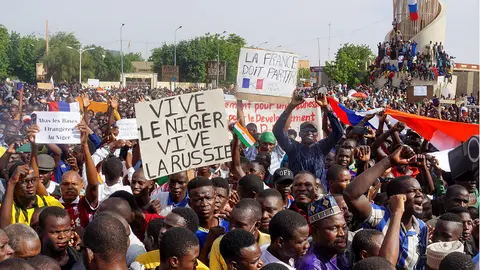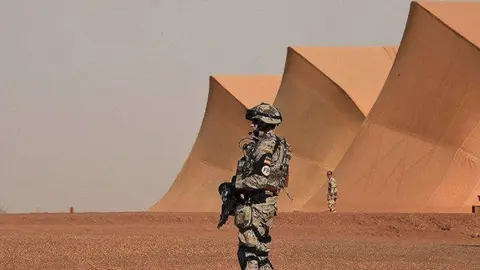A look to the south

The Sahel is the region of the world that concentrates the greatest number of threats to Europe's security. In an almost unmanageable area, impossible to control in its entirety, and which in recent years has developed a growing animosity, if not hatred, towards everything related to the West, we see some of the most characteristic causes of conflict in the 21st century: the degradation of government institutions, the decline of democratic systems, the proliferation of weapons, religious radicalism and the rise of organised crime and terrorism, whose networks are blurring together to form a whole.
At first glance, it may seem that everything that is happening there is far removed from us and that, except for the not inconsiderable risk of terrorism generated by religious radicalism jumping the "Mare Nostrum" and hitting us as it has already done on several occasions, the risk is contained. However, nothing could be further from the truth.
At the end of the last century and the beginning of this one, the main threat came from a potential conflict resulting from tensions between the two aspiring regional powers, namely Algeria and Morocco. However, the evolution of the region and the balances of power in the world, as well as the emergence of phenomena such as Daesh or the triggering of conflicts such as Russia's invasion of Ukraine, have had a perverse effect, resulting in a steady deterioration of the situation in the entire region. And this may lead to the emergence of a situation that irreversibly destabilises a key area for us.
The main risk comes from a scenario whose origin may be entirely local or accelerated by external catalysts interested in degrading Europe's situation and position, materialising the paradox of two actors, a priori enemies, in the territory of one of them, collaborating in the region controlled by the other, seeking a common goal. Having ruled out the scenario of a regional conflict, we must focus on the most likely scenario: a combination of the rise of Islamist terrorism, supported by organised crime networks and the collapse of democratic regimes, which will provoke not one, but successive waves of migration, as well as a situation of humanitarian catastrophe, which in an infernal vicious circle will be exploited by the jihadist networks to gain strength and swell their ranks, validating the argument that the worst possible scenario is always chaos.
The Sahel region has gradually become the world's main hotspot of terrorism. Burkina Faso, Mali and Niger are among the 10 most affected countries, according to the Global Terrorism Index. Large parts of their territories are beyond the control of state authorities, while the number of internally displaced persons (IDPs) has only increased over the past decade. This growing insecurity is the main cause of destabilisation of political regimes, as manifested in the number of coups d'état against democratically elected or even military regimes in all three countries, with a dangerous contagion effect as we have recently seen in Senegal.
The deteriorating security situation in Mali, Niger and Burkina Faso has also allowed jihadist armed groups to operate increasingly in the northern regions of Côte d'Ivoire, Benin and Togo. While these countries were already facing multidimensional internal threats, the number of terrorist attacks in their respective territories has been on an upward trend in recent years.
One is the ongoing struggle between Daesh and al-Qaeda for territorial hegemony; the other is the incorporation of age-old ethnic and racial rivalries into purely religious motives. And to all this we must add our myopia in trying to look at and understand what is happening through our Western lenses.
The key question here is: how are governments reacting to the rise of jihadist threats? More importantly in the current international context, what new security and foreign cooperation partnerships are governments in the region seeking? The EU's delayed but foreseeable withdrawal from the region has facilitated the creation of partnerships beyond what we might hitherto consider traditional ones. But these new bilateral and regional security arrangements raise serious questions about the compatibility of the various existing mechanisms and the security assistance provided by the new partners that have appeared on the scene.
What was already an open secret became clear after the leak of an internal report in 2022 ('Holistic Strategic Review of EUTM Mali and EUCAP Sahel Mali 2022') warned that if the EU drastically reduced its engagement in West Africa, the resulting vacuum would be filled by competitors such as Russia and other EU countries. This is exactly the dynamic we have seen in Mali, Burkina Faso and now Niger and, if the EU continues to look the other way, will witness in West African countries.
The situation seems to be on a slow but steady path towards total regional destabilisation, and the new partners that have entered the scene have a vital tool in their hands to influence its evolution as it suits their interests.
We cannot lose sight of the fact that one of the main indicators of potential conflict is inequality. And the Mediterranean, and more specifically the border between Spain and Morocco, make this one of the regions with the highest risk of conflict in the world. Morocco's per capita GDP is around 3,700 dollars, while Spain's is in the range of 31,000 dollars. But that is only the last link in the chain. The level of inequality between the North African countries with a Mediterranean coastline and those of the Sahel means that the per capita GDP of the former exceeds that of the latter by between five and seven times.
The conclusion is more than obvious: increased instability in the Sahel will mean that what are now movements of internally displaced persons, or even to coastal West African countries, will sooner rather than later take a northerly direction.
And it is unlikely that the countries bordering the southern shores of the Mediterranean will be able to withstand the pressure of the expected flood of migration. These countries are the first line of containment. If the pressure jumps that first rung, the problem will have arrived directly on our doorstep, and there will be nothing that can be done to stop what is coming. Such scenarios can be avoided by foresight, risk assessment and acting accordingly. Nothing can ever be solved with a reactive attitude. It is necessary to look at the long term, understand the dynamics and propose effective solutions in good time. This does not seem to be the case.
Since the coup in Mali, the EU's attitude in the region has been hesitant and the lack of determination, coupled with the mistakes accumulated over the years by the former colonial power in these countries, has created an atmosphere of rejection of anything that assimilates to Europe. This has pushed the new regimes to seek solutions with the support of new allies, who are not exactly looking for the good of the EU and have seen a window of opportunity to take control of critical resources while depriving the EU of access to them.
A very complicated scenario in which everything seems to be stacked against each other and which should make us reflect and pay more attention to what is happening. Because the real danger, without disregarding others, is in the south.




